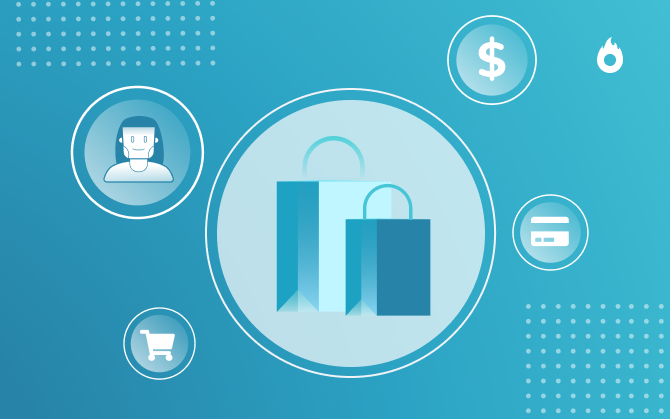
Consumer Behavior: Post-Covid Trends To Watch
Consumer behavior is constantly evolving and can be impacted by global events like the Covid-19 pandemic. Learn how to build the right strategies to win over customers in a post-covid world.

What will we see in this post
- Online shopping is booming and will continue to thrive
- Customers are looking for experts they can trust
- The feeling of uncertainty remains
- People are tired of being bombarded with ads
- Comparing products and prices has never been easier
- Poor website navigation and security discourage purchasing
- Buyers want to be part of a community
- Buyers have a low tolerance for errors

According to a recent study by Statista, 6 out of 10 US shoppers look for product information on Amazon, while 46% of them prefer browsing search engines when doing research. This study reveals an idea of how consumers nowadays identify and consider the products that they buy.
There are different types of consumers in the marketplace, and by learning about the ones in your niche, you’ll refine your messaging.
Consumer behavior refers to how people make buying decisions. Consumer behavior is important to marketers because it helps them understand what influences a consumer’s buying decision. Knowing what drives your prospects to choose one product over another can create better sales strategies for your business.
Consumer behavior is constantly evolving and can be impacted by global events like the Covid-19 pandemic. This is why more consumers shifted to shopping online as it was more convenient than physically visiting the stores.
How has the pandemic changed consumer behavior?
The Covid-19 pandemic changed not only how people work but also how they purchase goods. More businesses nowadays embrace remote or hybrid work, and consumers prefer buying goods online.
According to the Stackla Report, 67% of consumers say that their online purchasing has increased considerably since the pandemic. Social distancing was the biggest accelerator of the shift to online shopping. It altered how and why people shopped at a business, bought a product, and made them feel.
Businesses that ensured a frictionless online shopping experience for their consumers increased sales. From the same Stackla report, 72% of consumers said they would likely buy from a brand if it consistently provided a personalized online experience. 79% of consumers also believed that user-generated content and other forms of social proof like reviews determined if they would buy a product.
Post-pandemic, some consumer behavior trends that started with Covid-19 have remained while new ones emerged. And that is what we will discuss in this article.
1. Online shopping is booming and will continue to thrive
Even though technological advancements were already aiding the shift towards online shopping, the pandemic accelerated the shift more.
According to the 2022 GWI Commerce Report, 36% of Americans are doing most of their household and grocery shopping online. Some of their main reasons for doing so are convenience, lower prices, and low-cost shipping.
This shift in consumer behavior has caused many physical stores to launch eCommerce shops where their prospects can purchase goods online. They realize the value of offering their prospects a frictionless online shopping experience.
2. Customers are looking for experts they can trust
Today’s consumer behavior is marked by autonomy. Consumers prefer to research the products they need online and decide which one to go with without consulting any salesperson.
This means that digital influencers with a huge following on social media can easily determine which products their followers use. They can reach a large audience, dictate trends, and transform the opinions and behaviors of potential customers.
As a result, content creators have the opportunity to grow their influence and become authorities in their niches and earn the trust of followers. One great way to share expert knowledge is by creating an online course. If you need some valuable tips on how to do that, check out the video below:
VIDEO: How to Launch an Online Course | Hotmart Tips
3. The feeling of uncertainty remains
Humans are known to adapt quickly to changing times to survive. Following the pandemic, consumer behavior continues to shift to spending on the essentials, prioritizing products that will solve their problems.
According to the Consumers Unmasked Report, when consumers feel uncertain of the future, they become conscious of what they spend their money on. They look for quality products without the perception of overspending or a discount.
In such uncertain moments, purchases are driven by emotional factors rather than rational ones. As a content creator, you can appeal to consumers in such times by being consistent in your messaging, using psychological triggers, and revealing how your product can improve your prospects’ lives.
4. People are tired of being bombarded with ads
The average person is exposed to 10000 ads per day. But the volume is not even the main problem. According to Hubspot, ads are becoming more intrusive, inescapable, and annoying compared to 3 years ago.
Consumers are getting tired of constant bombardment with unwarranted ads wherever they go, insisting they buy things they’ve already bought or are not even interested in. The impact on consumer behavior is that more people are using ad blockers or choosing ad-free or premium versions of platforms when browsing online.
Blasting people with ads may only have short-term gains, but it negatively affects long-term brand building. People don’t want to feel like they are another target of a mysterious algorithm. Instead, they want to be an active part of the consumer relationship.
5. Comparing products and prices has never been easier
Comparing products and prices has become easier post-pandemic because consumer behavior shows people are now very familiarized with eCommerce stores. They can quickly browse through various online stores and get an idea of the average price for the product they want.
They can also look through the reviews left by past customers to determine the quality of the product, level of customer satisfaction, usability, and more. When they are done researching, consumers are usually aware of the best product for their needs without consulting a salesperson.
So, it’s important to take care of your online reputation to get ahead of your competitors. Share positive testimonials online, or encourage happy customers to leave reviews on review sites. For the negative reviews, leave a genuine response to the customer because prospects go through every review, especially the bad ones.
Also, invest in good customer service to prevent negative opinions about your business online. When you treat your customers the best way, they’ll spread the word to their friends and even try convincing them to buy your product.
6. Poor website navigation and security discourage purchasing
Consumer behavior demonstrates that buyers want a frictionless shopping experience. They don’t want to struggle to navigate your website to find what they are looking for. Instead, they want to locate the product they’re looking for quickly and check out without any hurdles.
Security is also a critical issue for consumers post-pandemic. Consumers don’t want to lose money to online scams. They also don’t like sites that demand unnecessary personal information when buying products.
As a product seller, ensure you have a smooth buying process, and a secure payment system. Create sales pages and checkouts that enable a good buying experience. You don’t want potential customers abandoning carts because they can’t complete the transaction.
Improve your site’s security by ensuring it has SSL encryption. So it reads HTTPS instead of just HTTP. In the case of accounts, demand that users create strong passwords to lock out cyber thieves.
7. Buyers want to be part of a community
Following the pandemic, more people joined online communities to neutralize social isolation and try to impact the world from home. If they couldn’t meet physically, they could talk online and contribute to something bigger.
Consumer behavior shows that buyers are more concerned with protecting the environment, sustainability, and social issues. They are not just looking for products to solve their immediate problems; they are inspired by brands with a mission to impact the world positively.
As a business, seek to create deep relationships with customers by showing them your strategic narrative. This is the mission your product and employees are working towards achieving. For example, Nike’s strategic narrative is to bring inspiration to every athlete in the world. And they help do this by providing high-quality shoes and equipment to athletes.
People who love that mission will join them and convince their friends to try Nike’s products too. Communities are powerful tools to help people tell stories and engage buyers, creating loyalty.
View this post on Instagram
8. Buyers have a low tolerance for errors
During the pandemic, many businesses that were not financially sound had to close down, while those that remained had to compete to meet consumer needs. Consumer behavior demonstrates that they prefer buying from companies with higher service standards due to the many alternatives.
Errors like delayed deliveries, low-quality products, or bad customer service forced consumers to shift to better companies. And this trend will continue. Consumers will keep on demanding high-quality services from businesses. They won’t think twice about changing their service provider.
As a business owner, ensure you optimize your operations to avoid losing existing and potential customers. Improve your payment processes and offer after-sales service to keep customers coming back.
Consumer behavior: get to know your ideal customer
You’ve just gone through some consumer behavior trends following the pandemic. We hope you’ve found the information helpful and will use them to improve your sales strategies.
Market research is essential to acquire customers and retain existing ones at any given period. First, you’ll know how to approach your prospects because you know what guides their purchasing behaviors. You’ll tailor your messaging to speak what they are looking for.
Second, you’ll improve the buying process, giving your prospects a positive experience. When buyers can easily navigate your website to identify the product they want and check out without any problems, they’ll come back next time.





